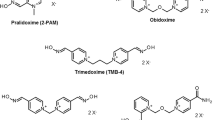Summary
Insecticide organophosphorus poisoning is characterised by ubiquitous inhibition of acetylcholinesterase, resulting in overstimulation of muscarinic and nicotinic receptors requiring immediate therapy. Besides supportive intensive care therapy measurements like primary and secondary elimination techniques such as gastric lavage and activated charcoal are important therapeutic options. The well established early antidotal treatment with atropine should counteract signs and symptoms of uncontrolled activation of muscarinic receptors. Frequent checking on dosage and duration of atropine therapy is recommended. Early oxime therapy should reactivate acetylcholinesterase by removing the phosphoryl group from the enzyme. Oximes are safe, while adverse reactions are rare and transient. Oxime treatment of diethylphosphoryl-AChE is known to be effective if the poison load is not too high, whereas the value of oxime therapy in case of dimethylphosphoryl-AChE is controversial and most likely only effective within the first few hours after ingestion. Determination of EryAChE and neuromuscular function is recommended for therapy control.
Zusammenfassung
Suizidal beabsichtigte Organophosphatvergiftungen führen durch ubiquitäre Hemmung der Cholinesterasen zur „cholinergen Krise“ und bedürfen einer sofort einzuleitenden Therapie. Neben der supportivintensivmedizinischen Behandlung stellt die Magenspülung als primäre und die Aktivkohlelavage als sekundäre Eliminationsmaßnahme eine sinnvolle Ergänzung der Pharmakotherapie dar. Die Antidottherapie mit Atropin zur effizienten Kupierung der muskarinergen Symptome muss frühzeitig einsetzen, eine engmaschige Überprüfung von Dosierung und Therapiedauer sollte stattfinden. Die frühzeitig begonnene Oximtherapie zur Reaktivierung gehemmter AChE stellt für Diethylphosphoryl-AChE eine sinnvolle Therapieoption dar. Sie ist nebenwirkungsarm, einfach und sicher in der Anwendung. Die Oximtherapie für Dimethylphosphoryl-OP-Verbindungen muss für den Einzelfall entschieden werden, ist jedoch wahrscheinlich nur innerhalb der ersten Stunden nach Gifteinnahme wirksam. Die Bestimmung der EryAChE sowie die Überprüfung der neuromuskulären Transmission sollten—sofern verfügbar—zur Steuerung der Therapie herangezogen werden.
Similar content being viewed by others
Author information
Authors and Affiliations
Rights and permissions
About this article
Cite this article
Eyer, F., Felgenhauer, N., Thiermann, H. et al. Aktuelle Empfehlungen zur Diagnostik und Therapie von Vergiftungen mit insektiziden Organophosphaten. Intensivmed 41, 322–330 (2004). https://doi.org/10.1007/s00390-004-0467-7
Received:
Accepted:
Issue Date:
DOI: https://doi.org/10.1007/s00390-004-0467-7



